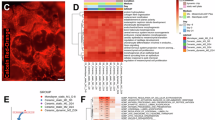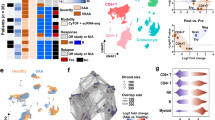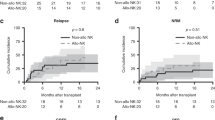Abstract
Graft rejection is an important problem in human bone marrow transplantation, with a 25–60% incidence in grafts between HLA–identical siblings1–6. In mice, two models of rejection of bone marrow grafts have been described: T-lymphocyte-mediated immunity and hybrid resistance (for reviews see refs 7, 8). The first model involves the recognition of foreign histo-compatibility (H–2) antigens by selected subsets of T lymphocytes. These antigen-reactive cells undergo clonal expansion and differentiate into cytotoxic effector cells which mediate graft rejection. In the hybrid resistance model, mononuclear cells, probably identical to natural killer (NK) cells, react against haematopoietic histocompatibility antigens on parental marrow cells9. Cells involved in hybrid resistance exhibit ‘spontaneous’ cytotoxicity to disparate haematopoietic cells and, in contrast to T-lymphocyte-mediated immunity, do not require a sensitisation phase before differentiating into cytotoxic effector cells. The mechanism of graft rejection following bone marrow transplantation in man is unknown. In transplants between HLA-identical siblings the target antigens of graft rejection are not HLA or antigens closely linked to the major histocompatibility complex (MHC). To study the problem of graft rejection in man we developed and describe here an in vitro model to detect immunity to haematopoietic stem cells committed to granulocyte–macrophage differentiation (CFU-C; colony-forming unit culture). We found that human peripheral blood and bone marrow but not thymus contain a population of cells which are cytotoxic to haematopoietic stem cells following in vitro sensitisation. The effector cell population is not a conventional T or B lymphocyte, monocyte–macrophage or NK cell.
This is a preview of subscription content, access via your institution
Access options
Subscribe to this journal
Receive 51 print issues and online access
$199.00 per year
only $3.90 per issue
Buy this article
- Purchase on SpringerLink
- Instant access to full article PDF
Prices may be subject to local taxes which are calculated during checkout
Similar content being viewed by others
References
UCLA Bone Marrow Transplant Team Lancet ii, 921 (1976).
Storb, R. et al. Transplantn Proc. 10, 135 (1978).
Gluckman, F. et al. Transplantn Proc. 10, 141 (1978).
Elfenbein, G. H., Anderson, P. N., Klein, D. L., Schacter, D. Z. & Santos, G. W. Transplantn Proc. 10, 441 (1978).
ACS/NIH Bone Marrow Transplant Registry J. Am. med. Ass. 236, 1131 (1976).
Camitta, B. M. et al. Blood 48, 63 (1976).
Cerrottini, J. C. & Brunner, K. T. Adv. Immun. 18, 67 (1974).
Cudkowicz, G., Landy, M. & Shearer, G. M., (eds) Natural Resistance Systems Against Foreign Cells, Tumors, and Microbes (Academic, New York, 1978).
Kiessling, R. et al. Eur. J. Immun. 7, 655 (1977).
Golde, D. W. & Cline, M. J. Blood 41, 45 (1973).
Pike, B. L. & Robinson, W. A. J. cell. Physiol. 76, 77 (1970).
Cline, M. J. & Billing, R. J. exp. Med. 146, 1143 (1977).
Winchester, R. J. et al. Proc. natn. Acad. Sci. U.S.A. 74, 4102 (1977).
Billings, R. J., Honig, R., Peterson, P., Safani, M. & Terasaki, P. J. Immun. 117, 2040 (1976).
Mann, D. L., Abelson, L., Henkart, P., Harris, S. D. & Amos, D. B. Proc. natn. Acad. Sci. U.S.A. 72, 5103 (1975).
Golde, D. W. & Cline, M. J. J. clin. Invest. 51, 2981 (1972).
Saxon, A., Feldhous, J. & Robins, R. A. J. immun. Meth. 12, 285 (1976).
Billing, R., et al. J. exp. Med. 144, 167 (1976).
Billing, R., Ting, A. & Terasaki, P. J. natn. Cancer Inst. 58, 199 (1977).
Takasugi, M., Mickey, M. R. & Terasaki, P. I. Cancer Res. 33, 2898 (1973).
Takasugi, M., Mickey, M. R. & Terasaki, P. I. J. natn. Cancer Inst. 53, 1527 (1974).
Targan, S. & Jondal, M. J. immun. Meth. 22, 123 (1978).
Author information
Authors and Affiliations
Rights and permissions
About this article
Cite this article
Gale, R., Moran, C. Immunity to human haematopoietic stem cells. Nature 281, 220–222 (1979). https://doi.org/10.1038/281220a0
Received:
Accepted:
Published:
Issue date:
DOI: https://doi.org/10.1038/281220a0



